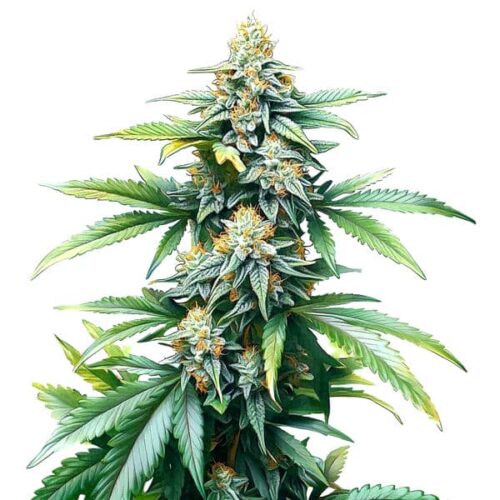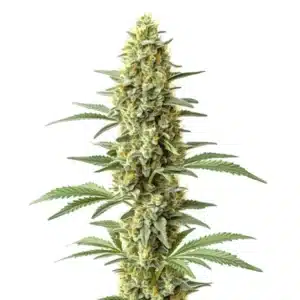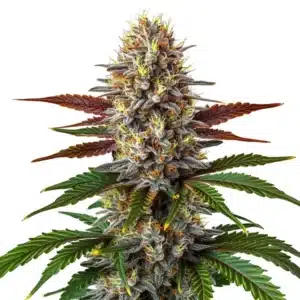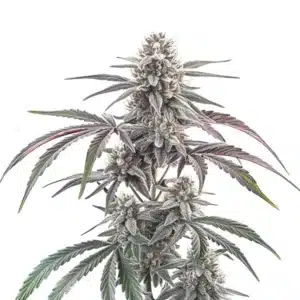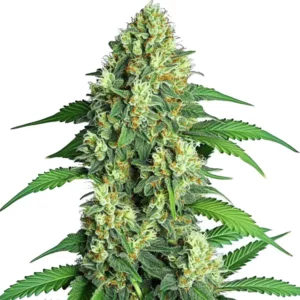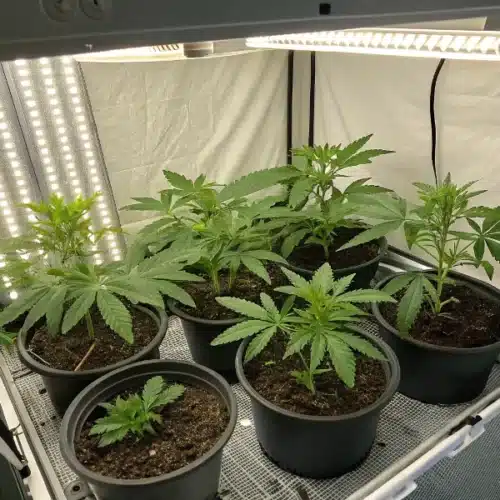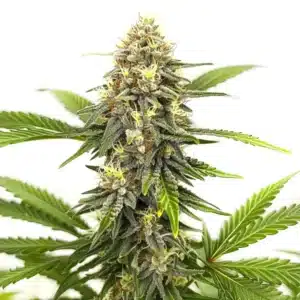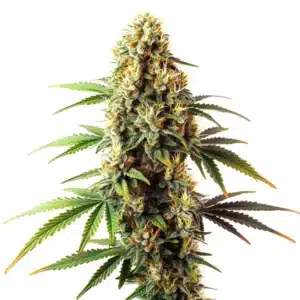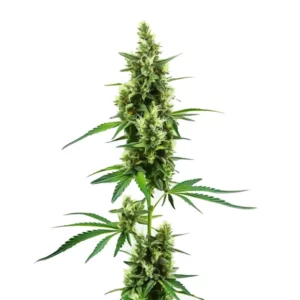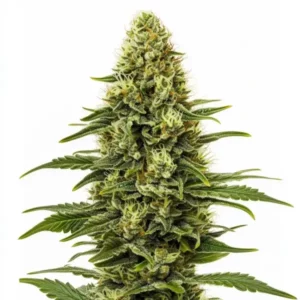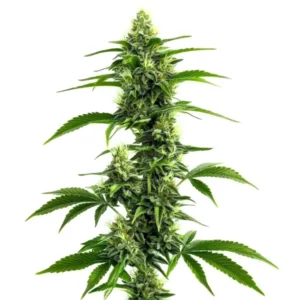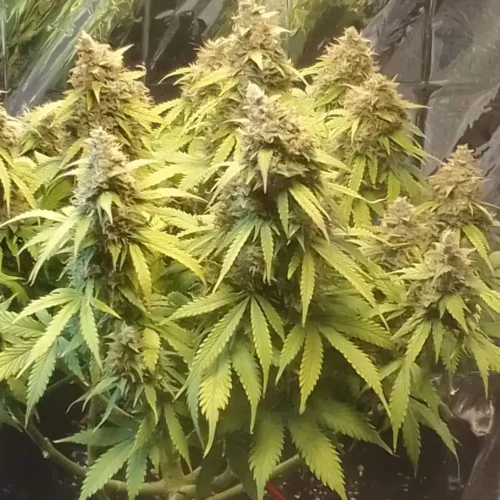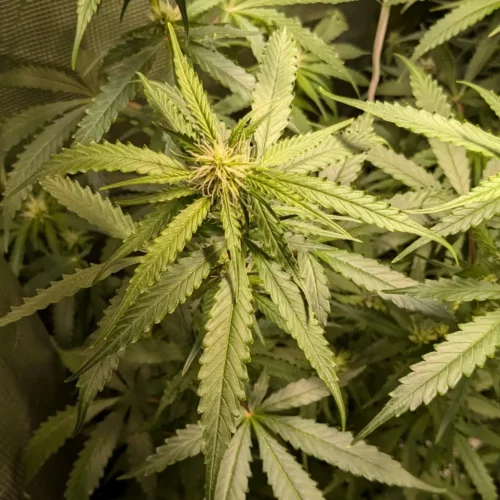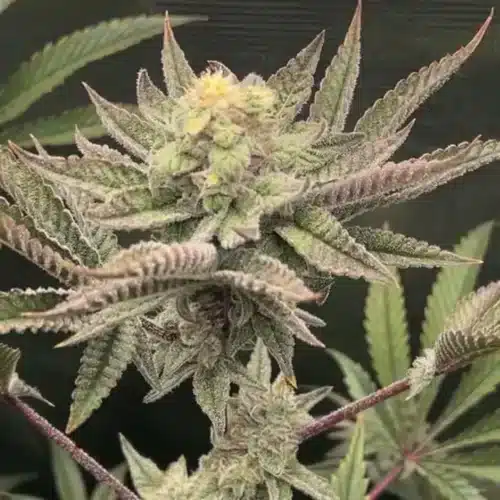Afghan Kush Weed Regular Description
Afghan Kush Regular is a powerful and classic cannabis strain that originates from the Hindu Kush mountain range. Known for its robust, full-bodied Indica effects, this strain has become a staple in cannabis cultivation, appreciated by both recreational and medicinal users. Its genetics are rooted in landrace strains, providing a naturally strong and resilient plant that is perfect for traditional cannabis enthusiasts.
Recommended Strains
Afghan Kush Regular
 THC: 18% - 22%
THC: 18% - 22% Type of seed: Regular
Type of seed: Regular Phenotype: Mostly Indica
Phenotype: Mostly Indica Day to flower: 8 - 10 weeks
Day to flower: 8 - 10 weeks
This strain is a cross between the iconic OG Kush and Banana Kush, producing a mostly Indica hybrid that is renowned for its dense, resinous buds. The buds often display vibrant shades of green with hints of purple, making them visually appealing. Afghan Kush Weed Regular is also famous for its potent, relaxing effects, making it a go-to strain for those looking to unwind.
One of the standout features of this strain is its rich and complex aroma and flavor profile. It combines fruity and tropical notes, with flavors reminiscent of apples and sweet fruits. These delectable flavors are further enhanced by the terpene profile, which includes Alpha Cedrene, Alpha Humulene, and Beta-Caryophyllene. These terpenes not only contribute to the strain’s delightful taste but also to its therapeutic effects, making it highly sought after by medical cannabis users.
Promos & Deals
Environmental Requirements for Growing Afghan Kush
Afghan Kush Weed Regular thrives in environments that replicate its origins in the rugged mountains of the Hindu Kush. Understanding the environmental needs of this strain will ensure a healthy grow and a bountiful harvest. Afghan Kush Regular is suited for both indoor and outdoor cultivation, though growers will need to pay close attention to the environmental conditions, especially if growing indoors.
In an indoor setup, this strain requires a stable temperature range of 70-80°F (21-27°C) during the day, with slightly cooler temperatures at night. This strain prefers lower humidity levels, particularly during the flowering stage, to prevent mold or mildew from forming on its dense buds. It’s recommended to maintain humidity levels at around 40-50% during flowering to achieve optimal results.
When growing this strain outdoors, it’s important to choose a location with plenty of sunlight and well-draining soil. The plant’s hardy genetics allow it to thrive in a variety of climates, but it performs best in warm, Mediterranean-like environments. If you’re in a cooler region, a greenhouse or additional protection may be needed to extend the growing season and protect the plants from adverse weather.
Setting Up The Growing Cannabis Space
Indoor Cannabis Cultivation
For indoor cultivation, it’s essential to set up a well-ventilated space for Afghan Kush, as its bushy structure requires good airflow to prevent mold and pests. A grow tent with proper ventilation and an exhaust system will ensure a fresh and clean growing environment. Additionally, using high-quality LED lights or HPS lamps will provide the necessary light spectrum for strong bud development.
This strain typically grows to a medium height, around 4.92 ft (1.5 m), making it suitable for indoor growing spaces. Use reflective materials, such as Mylar sheets, to maximize light distribution. Afghan Kush Weed Regular performs well in both soil and hydroponic setups, but the key is to ensure proper drainage. Maintaining a pH level of 6.0-6.5 is ideal for nutrient absorption, ensuring the plant thrives throughout its growth cycle.
Outdoor Cannabis Cultivation
When growing this strain outdoors, selecting the right location is crucial. Choose a spot that receives ample sunlight and has well-draining soil to avoid waterlogged roots. Afghan Kush Weed Regular is naturally resistant to many pests and molds, but proper care and attention to environmental conditions will help you maximize yields. It’s also recommended to use stakes or trellises to support the branches, as the weight of the buds can cause them to bend or break.
Outdoor growers should expect this strain to reach full maturity and be ready for harvest within 8-10 weeks. Afghan Kush Regular is an all-season strain, but its harvest time generally falls in October, depending on the local climate and growing conditions.
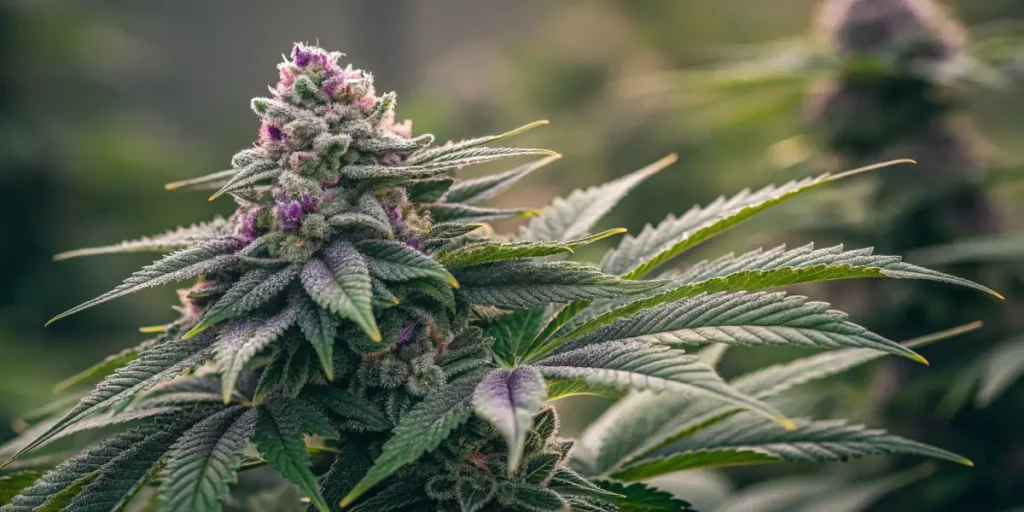
Propagation and Germination of Afghan Kush
Successful germination is the foundation of any thriving cannabis plant. Here’s how to properly germinate your Afghan Kush Weed Regular seeds:
- Start by choosing high-quality this strain seeds from a trusted seed bank like Blimburn Seeds. Ensure the seeds are stored in a cool, dark place before starting the germination process.
- Soak the seeds in distilled water for 24-48 hours to soften the seed coat and promote faster germination. After soaking, transfer the seeds to a damp paper towel, keeping them in a warm (70-85°F or 21-29°C) and dark place.
- Once the taproots appear, transfer the seeds to small pots or seedling trays filled with a light, well-draining soil mix. Keep the environment warm and humid, with a humidity level around 60-70% during the germination phase.
- As the seedlings develop, provide them with indirect light for the first few days. Gradually increase light exposure to encourage healthy growth. Avoid exposing them to intense light or heat during this delicate stage.
Following these steps ensures a high germination rate and lays the groundwork for strong, healthy plants.
Vegetative Phase of Afghan Kush Weed Regular
The vegetative stage is where this strain establishes its roots and structure. During this phase, the plant focuses on producing leaves and stems, which are vital for later stages of growth. Here are key considerations for this phase:
Lighting: Provide 18-20 hours of light daily during the vegetative phase. High-quality LED grow lights or HPS lamps are recommended to ensure the plants receive sufficient light intensity for rapid growth. Afghan Kush Weed Regular grows vigorously during this stage, preparing for its heavy bud production later on.
Nutrition: In this phase, this strain requires a nutrient-rich diet, particularly high in nitrogen (N), to support leafy growth. You can use a reputable cannabis fertilizer or organic amendments to ensure your plants receive the necessary nutrients for strong vegetative development.
Watering: Keep the soil moist but not waterlogged, allowing the top inch of the soil to dry out between watering. This prevents root rot and promotes strong root development.
Flowering Phase
During the flowering phase, this strain will begin to develop dense, resin-covered buds. This is the most exciting part of the grow cycle, and proper care during this phase is critical for maximizing your yield.
Lighting: Switch to a 12/12 light cycle (12 hours of light and 12 hours of complete darkness) to trigger flowering. Afghan Kush Weed Regular generally flowers within 8-10 weeks, though individual phenotypes may vary slightly.
Nutrition: Transition to a bloom-specific fertilizer that is rich in phosphorus (P) and potassium (K) to promote healthy bud development. Monitoring your plants closely during this phase is important, as they may show signs of nutrient deficiencies that need to be addressed promptly.
Temperature and Humidity: Lower the temperature slightly to around 65-75°F (18-24°C) and keep humidity between 40-50% to prevent mold from forming on the dense buds. Providing proper airflow will also help maintain the health of the plant.
Cannabis Fertilization and Nutrition
To maximize the health and productivity of your Afghan Kush, providing the right nutrition at the right time is key. Afghan Kush Weed Regular thrives on a nutrient-rich diet during both the vegetative and flowering stages.
Choosing the Right Fertilizer: Use a balanced fertilizer during the vegetative phase that is rich in nitrogen (N) to support leaf and stem growth. Transition to a bloom formula with higher phosphorus (P) and potassium (K) during the flowering phase to promote large, resinous buds.
Supplements and Additives: Adding beneficial microbes, mycorrhizae, or enzymes to the soil will improve nutrient uptake and boost the overall health of your plants. You can also consider bloom boosters to enhance bud production.
Pest And Disease Control for Cannabis Growing
Though this strain is a hardy and resilient strain, it is still susceptible to common cannabis pests and diseases. Implementing proper pest and disease management strategies is essential for a successful grow.
- Inspect plants regularly for pests such as spider mites, aphids, and thrips. Early detection is critical for preventing infestations.
- Ensure proper airflow and maintain a clean growing environment to reduce the risk of mold and mildew, especially during the flowering stage.
- Consider introducing beneficial insects like ladybugs or predatory mites to naturally control pest populations.
Harvesting and Curing for Cannabis Growing
Harvesting Afghan Kush Weed Regular at the right time is crucial to preserve its potency, flavor, and aroma. Here’s how to ensure a successful harvest and proper curing process:
Trichome Maturity: Monitor the trichomes using a magnifying tool. Harvest this strain when the trichomes are mostly cloudy with some turning amber. This indicates the peak cannabinoid content, providing the best combination of effects.
Harvesting: Use sterilized scissors or pruning shears to cut down each branch. Be gentle to avoid damaging the buds. Trim away any excess fan leaves while leaving the sugar leaves intact to protect the buds during drying.
Drying: Hang the trimmed branches upside down in a dark, well-ventilated space with a temperature of 60-70°F (15-21°C) and humidity levels of 50-60%. The drying process typically takes about 7-14 days, depending on environmental conditions. Be sure to avoid overcrowding the drying area to prevent mold formation.
Curing: Once the buds are dry, carefully remove them from the branches and store them in airtight glass jars. Place the jars in a cool, dark place and open them daily during the first week to allow excess moisture to escape. Continue this process for 2-4 weeks to fully cure the buds, enhancing the flavors and overall potency.
Is Afghan Kush Weed Regular Indica or Sativa?
Afghan Kush Weed Regular is a pure Indica strain, known for its heavy, relaxing effects. As a landrace strain from the Hindu Kush region, it has a long-standing reputation for providing a deeply calming body high. The predominance of Indica genetics makes this strainr an excellent strain for evening or nighttime use, as it helps ease stress, relax muscles, and prepare the body for restful sleep.
While this strain doesn’t offer the cerebral effects typical of Sativa strains, its powerful physical relaxation and euphoric body high make it ideal for users seeking relief from conditions like pain, insomnia, and anxiety. This strain is highly regarded for its therapeutic properties, which is why it remains a favorite among medical cannabis users.

Advantages of Growing Afghan Kush
Growing this strain presents several key advantages that make it a desirable choice for cannabis cultivators:
- Robust Genetics: As a landrace strain, this strainr is naturally resilient to various pests, molds, and environmental stresses. This makes it easier to grow compared to more delicate hybrid strains.
- Strong Indica Effects: Afghan Kush Weed Regular offers a heavy body high that is perfect for relaxation and pain relief, making it highly appealing for both recreational and medicinal users.
- Rich Flavors and Aromas: The fruity, sweet, and tropical flavors of Afghan Kush Weed Regular are further enhanced by its terpene profile, making it a delight for the senses.
- High Yields: With proper care and the right environmental conditions, this strain can produce generous yields of dense, resinous buds.
Disadvantages
- Slow Growth: Afghan Kush Weed Regular can have a relatively slow vegetative growth phase compared to faster-growing hybrids, which may require more time and patience.
- Heavy Odor: The strong aroma of this strain during flowering may require the use of odor control systems like carbon filters to prevent the scent from becoming overwhelming.
- Not for Beginners: Afghan Kush Regular is best suited for more experienced growers, as it can be sensitive to certain environmental factors and requires proper care and attention.
Why Buy Afghan Kush
There are several compelling reasons to consider purchasing Afghan Kush:
- Classic Indica Effects: Afghan Kush Weed Regular provides a deeply relaxing body high, making it a top choice for those looking to unwind or alleviate physical discomfort.
- Rich Terpene Profile: This strain’s fruity and tropical flavors are highly appealing, especially for cannabis connoisseurs seeking a flavorful smoking experience.
- Medicinal Benefits: Afghan Kush Regular is popular among medical cannabis users for its ability to ease pain, reduce stress, and promote restful sleep.
- Resilient Genetics: Afghan Kush’s landrace lineage makes it naturally resistant to pests and molds, giving it an edge in outdoor and indoor cultivation alike.
Problems in Cultivating Afghan Kush
Despite its resilient nature, this strain can present a few challenges during cultivation. Here are some issues to watch out for:
- Nutrient Sensitivity: Can be sensitive to nutrient imbalances, particularly in hydroponic systems. Overfeeding can lead to nutrient burn, while underfeeding can stunt growth. Monitoring pH levels and adjusting nutrient concentrations is key to avoiding these problems.
- Humidity Control: Due to its dense bud structure, this strain is prone to mold and mildew, especially in high-humidity environments. Ensure proper ventilation and maintain optimal humidity levels to avoid mold issues.
- Odor Control: Afghan Kush Weed Regular is known for its pungent aroma during the flowering stage. Growers in urban or indoor settings may need to invest in carbon filters or other odor control measures to keep the scent discreet.
Strains Similar to Afghan Kush
Here are three strains that share similar qualities with Afghan Kush:
- Northern Lights Regular: Another pure Indica strain known for its relaxing effects and resistance to pests, Northern Lights is a great alternative for those seeking a heavy body high with a rich flavor profile.
- Hindu Kush Regular: A close relative of Afghan Kush, this landrace Indica strain offers similar effects and flavors, making it ideal for fans of traditional Indica varieties.
- Blueberry Regular : This Indica-dominant strain combines fruity flavors with calming effects, making it a popular choice for users looking for relaxation and flavor.
Tips for Professional Growers
- Optimize Your Growing Environment: Ensure precise control over temperature, humidity, and light exposure to maximize Afghan Kush’s yields and potency.
- Use Trellis Systems: Support the plant’s branches during the flowering stage to prevent breakage under the weight of the buds.
- Keep a Close Eye on Nutrients: Regularly monitor pH and nutrient levels to avoid nutrient lockout or deficiencies, especially when growing in hydroponics.
- Harvest at the Right Time: Use a magnifying glass to monitor trichome development and harvest when they reach their peak potency for the best results.
- Cure for Flavor: Proper curing will enhance Afghan Kush’s natural terpene profile, bringing out its full flavor and aroma.
FAQs
What is Afghan Kush Weed Regular?
Afghan Kush Weed Regular is a potent and classic cannabis strain originating from the Hindu Kush mountain range. It is a mostly Indica hybrid known for its relaxing effects and dense, resinous buds. The strain is highly valued for its rich, fruity flavors and medicinal properties, making it a popular choice among recreational and medicinal users alike.
What are the environmental requirements for growing Afghan Kush Weed Regular?
Afghan Kush Weed Regular thrives in stable environments with a temperature range of 70-80°F (21-27°C) during the day and slightly cooler temperatures at night. It requires low humidity, particularly during the flowering stage, to avoid mold. Outdoor cultivation should take place in sunny areas with well-draining soil, while indoor setups should include good ventilation and light distribution.
How do you properly germinate Afghan Kush Weed Regular seeds?
To germinate Afghan Kush seeds, soak them in distilled water for 24-48 hours, then transfer them to a damp paper towel placed in a warm, dark environment. Once the taproots appear, plant the seeds in a light, well-draining soil mix. Maintain humidity at 60-70% and provide indirect light during the initial stages of growth.
What are the advantages of growing Afghan Kush Weed Regular?
Growing Afghan Kush offers several advantages, including its robust genetics, which make it resistant to pests and molds. The strain produces high yields of dense, resinous buds, and its rich fruity and tropical flavors are enhanced by a unique terpene profile. It is well-suited for both recreational and medicinal users due to its potent, relaxing effects.
What challenges might arise when cultivating Afghan Kush Weed Regular?
Despite its resilience, Afghan Kush can present challenges such as nutrient sensitivity, particularly in hydroponic systems. Overfeeding or underfeeding can stunt growth. The dense buds are prone to mold and mildew in high humidity, so careful humidity control and ventilation are necessary. Additionally, the strong aroma during the flowering stage may require odor control measures in indoor or urban settings.

